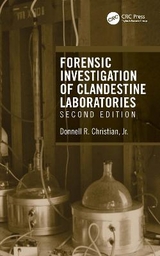
Forensic Investigation of Clandestine Laboratories
Seiten
2003
Crc Press Inc (Verlag)
978-0-8493-1227-4 (ISBN)
Crc Press Inc (Verlag)
978-0-8493-1227-4 (ISBN)
- Titel erscheint in neuer Auflage
- Artikel merken
Zu diesem Artikel existiert eine Nachauflage
Addresses various issues involved in the forensic investigation and prosecution of clandestine labs. This book explains how to identify the controlled substances that are being manufactured and the methods used in the manufacturing process. It also shows how to collect and preserve evidence and provides insight into evidence analysis.
Clandestine lab operators are not the mad scientists whose genius keeps them pent up in the laboratory contemplating elaborate formulas and mixing exotic chemicals. In fact, their equipment is usually simple, their chemicals household products, and their education basic. Most of the time the elements at the scene are perfectly legal to sell and own. It is only in the combination of all these elements that the lab becomes the scene of a criminal operation.
Forensic Investigation of Clandestine Laboratories guides you, step-by-step, through the process of recognizing these illegal manufacturing operations. Then it shows you how to prove it in the courtroom. In non-technical language this book details:
How to recognize a clandestine lab
How to process the site of a clandestine lab
How to analyze evidence in the examination laboratory
What to derive from the physical evidence
How to present the evidence in court
The identification and investigation of a clandestine lab, and the successful prosecution of the perpetrators, is a team effort. A collaboration of law enforcement, forensic experts, scientists, and criminal prosecutors is required to present a case that definitively demonstrates how a group of items with legitimate uses are being used to manufacture an illegal controlled substance. Providing an understanding of how the pieces of the clandestine lab puzzle fit together, this book outlines the steps needed to identify and shut down these operations, as well as successfully prosecute the perpetrators.
Clandestine lab operators are not the mad scientists whose genius keeps them pent up in the laboratory contemplating elaborate formulas and mixing exotic chemicals. In fact, their equipment is usually simple, their chemicals household products, and their education basic. Most of the time the elements at the scene are perfectly legal to sell and own. It is only in the combination of all these elements that the lab becomes the scene of a criminal operation.
Forensic Investigation of Clandestine Laboratories guides you, step-by-step, through the process of recognizing these illegal manufacturing operations. Then it shows you how to prove it in the courtroom. In non-technical language this book details:
How to recognize a clandestine lab
How to process the site of a clandestine lab
How to analyze evidence in the examination laboratory
What to derive from the physical evidence
How to present the evidence in court
The identification and investigation of a clandestine lab, and the successful prosecution of the perpetrators, is a team effort. A collaboration of law enforcement, forensic experts, scientists, and criminal prosecutors is required to present a case that definitively demonstrates how a group of items with legitimate uses are being used to manufacture an illegal controlled substance. Providing an understanding of how the pieces of the clandestine lab puzzle fit together, this book outlines the steps needed to identify and shut down these operations, as well as successfully prosecute the perpetrators.
Basic Clandestine Drug Manufacture. Clandestine Lab Hazards. Basic Toxicology. Scene Processing. Laboratory Analysis. Opinions. Testimony. Explosive Labs. Practical Applications. APPENDICES: Clandestine Equipment Alternatives. Chemical Information. Hazard Information. Chemical Reagent Recipes. Analytical Data. Methods and Calculations. Glossary. References.
| Erscheint lt. Verlag | 28.7.2003 |
|---|---|
| Zusatzinfo | 39 Tables, black and white; 62 Halftones, black and white; 123 Illustrations, black and white |
| Verlagsort | Bosa Roca |
| Sprache | englisch |
| Maße | 156 x 234 mm |
| Gewicht | 680 g |
| Themenwelt | Naturwissenschaften ► Chemie ► Analytische Chemie |
| Recht / Steuern ► Allgemeines / Lexika | |
| Recht / Steuern ► EU / Internationales Recht | |
| Recht / Steuern ► Strafrecht ► Kriminologie | |
| ISBN-10 | 0-8493-1227-2 / 0849312272 |
| ISBN-13 | 978-0-8493-1227-4 / 9780849312274 |
| Zustand | Neuware |
| Haben Sie eine Frage zum Produkt? |
Mehr entdecken
aus dem Bereich
aus dem Bereich



